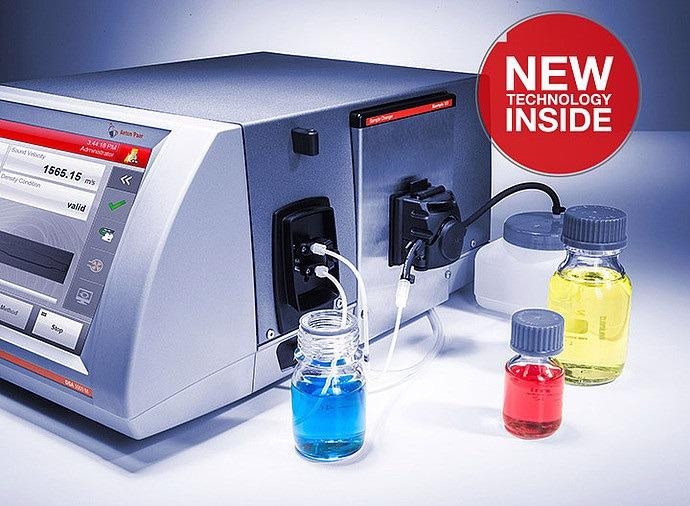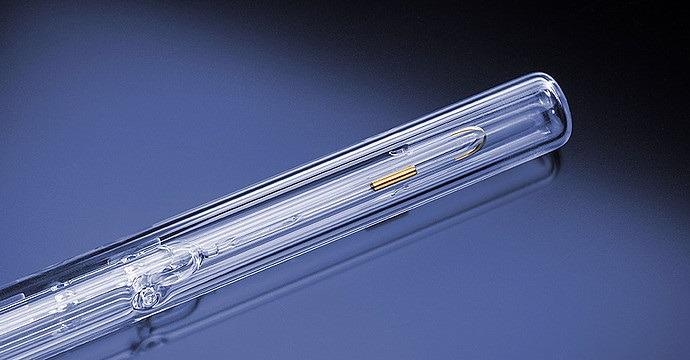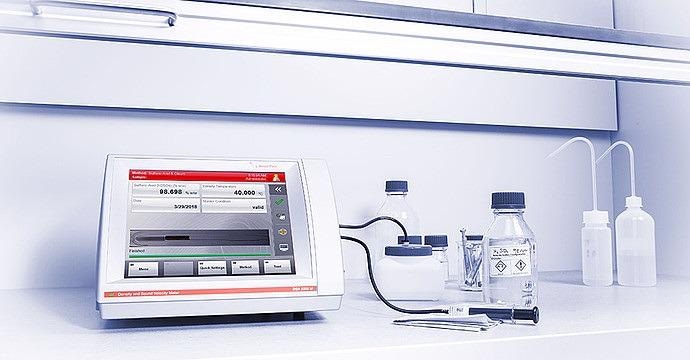Anton Paar’s DSA 5000 M is the only instrument that integrates density and sound velocity measurements in just a single setup.
Already, in several different industries, R&D departments are utilizing the opportunity to quantify both parameters in one stroke. It is the only method to find the concentration of sulfuric acid over the complete concentration range with just a single instrument.
- Quantifies the entire concentration range of oleum and sulfuric acid
- Perfect for phosphoric acid, methanol, formaldehyde, paints
- The least sample volume increases safety for laboratory personnel
- Identifies the concentration of two- and three-component solutions

Image Credit: Anton Paar GmbH

Image Credit: Anton Paar GmbH

Image Credit: Anton Paar GmbH
Key Features
A Revolutionary Measuring Principle for the Market-Leading Density and Sound Velocity Meter
The special design of the measuring cell, a new method of assessing the oscillation characteristics, and several other innovative features make DSA 5000 M one of a kind.
The Best in Accuracy, Repeatability and Reproducibility
DSA 5000 M offers the best outcomes that are commercially available
- Density: Repeatability possible up to the 7th digit
- Reproducibility: 0.000005 g/cm³ (density), 0.5 m/second (sound velocity)
- Sound velocity: Repeatability up to 0.1 m/second

Image Credit: Anton Paar GmbH
Eliminates Temperature Drifts
The ThermoBalance™ technology guarantees that this precision has reached under any temperature ranging up to 100 °C. A reference oscillator is utilized to remove temperature-related fluctuations of the glass tube – even after years of operation.

Image Credit: Anton Paar GmbH
The Fastest Way to Determine Sulfuric Acid Concentration
The combination of sound velocity and density measurements guarantees that users notice even the smallest of deviations in their production process.
DSA 5000 M is the quickest method to quantify sulfuric acids and the only way to quantify sulfuric acid over the entire concentration range in just a single instrument.

Image Credit: Anton Paar GmbH
Detects Filling Errors and Gas Bubbles
FillingCheck™ helps detect filling errors and gives a warning signal if particles or gas bubbles in users’ samples have been found. The feature will give users a “go” to start the measurement if users have filled their sample properly.
It is also possible for users to check the U-View™ camera that exhibits and stores live images of the filled U-tube. This real-time monitoring warns users of mistakes immediately and provides users with the peace of mind that their results are not distorted by filling errors.

Image Credit: Anton Paar GmbH
One Sample, One Measurement Cycle, Numerous Results
DSA 5000 M recovers various parameters from the same sample.
Measured Parameters
Derived Measurands
- Measurement of concentration of two-component solutions
- Adiabatic compressibility
- Concentration determination of three-component solutions

Image Credit: Anton Paar GmbH
The Most Stable Results Available
The viscosity correction is accountable for the high repeatability of density results in DSA 5000 M. It removes viscosity-related errors twice as efficiently as ever before and functions automatically throughout the complete viscosity range of users’ samples.
As a result of this technology, it is possible for users to detect the smallest deviations in their constant production and rapidly react to reduce downtimes. The viscosity correction comes calibrated ex-factory so users will never require viscosity standards, thereby saving time for calibration and money for standards.

Image Credit: Anton Paar GmbH
Technical Specifications
Source: Anton Paar GmbH
| Patents |
|
| Patents granted |
AT 516420 (B1), AT 517082 (B1) |
| Patents pending |
AT 517486 (A1) |
| Measuring range |
|
| Density |
0 to 3 g/cm3 |
| Sound velocity |
1000 to 2000 m/s |
| Temperature range |
0 °C to 100 °C (32 °F to 212 °F) |
| Pressure range |
0 bar to 8 bar (0 psi to 116 psi) |
| Accuracy |
|
| Density* |
0.000007 g/cm3 |
| Concentration determination |
Typically 0.01 to 0.1 % (application-dependent) |
| Digital Resolution |
|
| Density |
0.000001 g/cm3 |
| Sound velocity |
0.01 m/s |
| Repeatability s.d.** |
|
| Density |
0.000001 g/cm3 |
| Sound velocity |
0.1 m/s |
| Temperature |
0.001 °C |
| 0 to 100 % H2SO4 |
0.02 % H2SO4 |
| 0 to 28 % free SO3 |
0.04 % free SO3 |
| 28 to 65 % free SO3 |
0.1 % free SO3 |
| Additional information |
|
| Integrated tables and functions |
- Ethanol tables
- Extract/sugar tables
- Acid/base tables
- 20 freely programmable user functions
|
| Available options |
- ISO 17025 calibration providing full traceability to SI units
- Cooling kit for low-temperature measurement
|
| Amount of sample in the measuring cells |
3 mL |
| Measuring time per sample |
1 to 4 minutes |
| Interfaces |
RS-232, 4 x USB, CAN, VGA, Ethernet |
| Display |
Bright 10.4" TFT PCAP touchscreen (640 x 480 px) with customizable display layout |
| Wetted parts |
PTFE, borosilicate glass, stainless steel DIN 1.4539/UNS N08904 |
| Dimensions |
495 x 330 x 230 mm
(19.5 x 13 x 9.1 in) |
| Weight |
22.5 kg (49.6 lbs) |
* Under ideal conditions and for low densities/viscosities
** According to ISO 5725